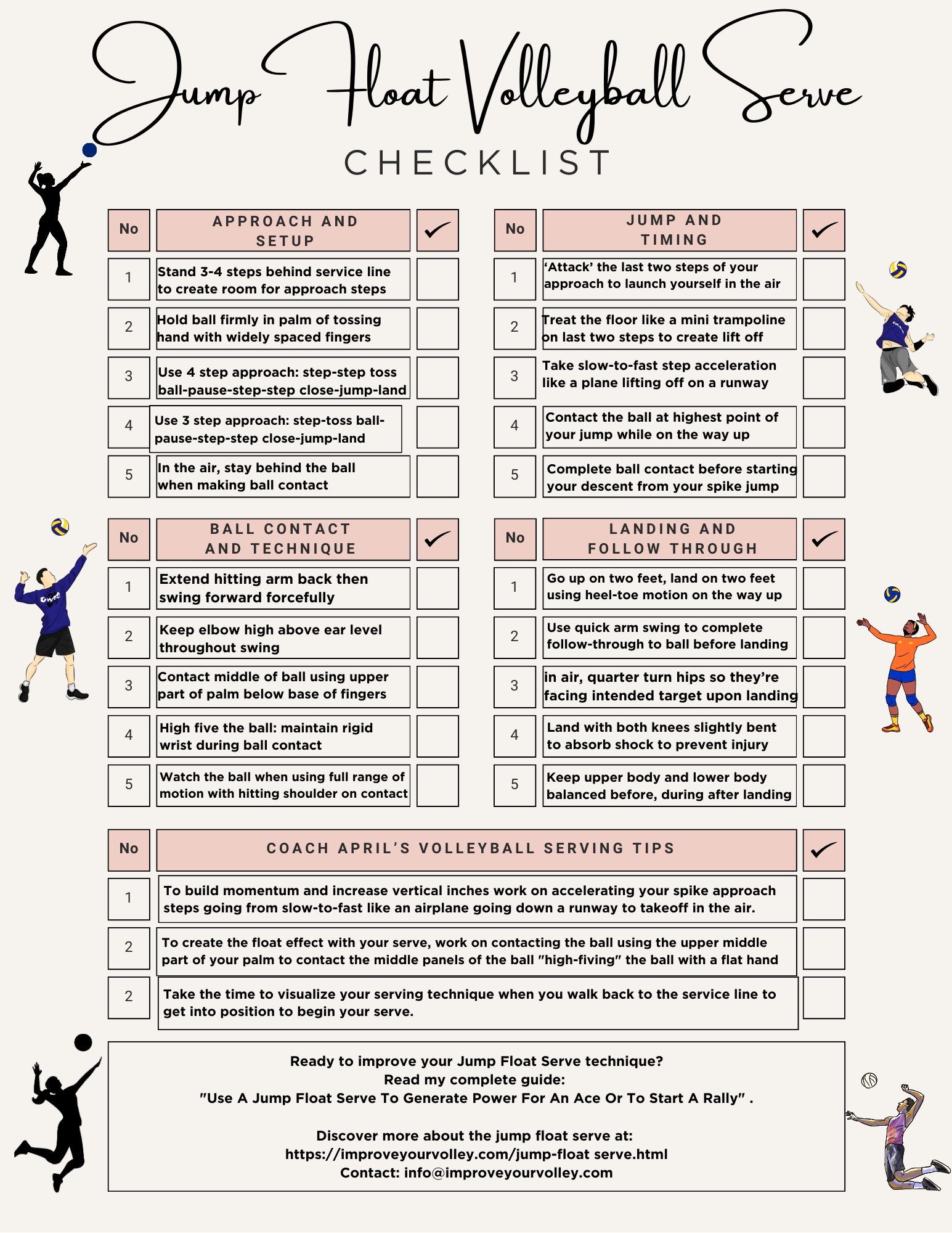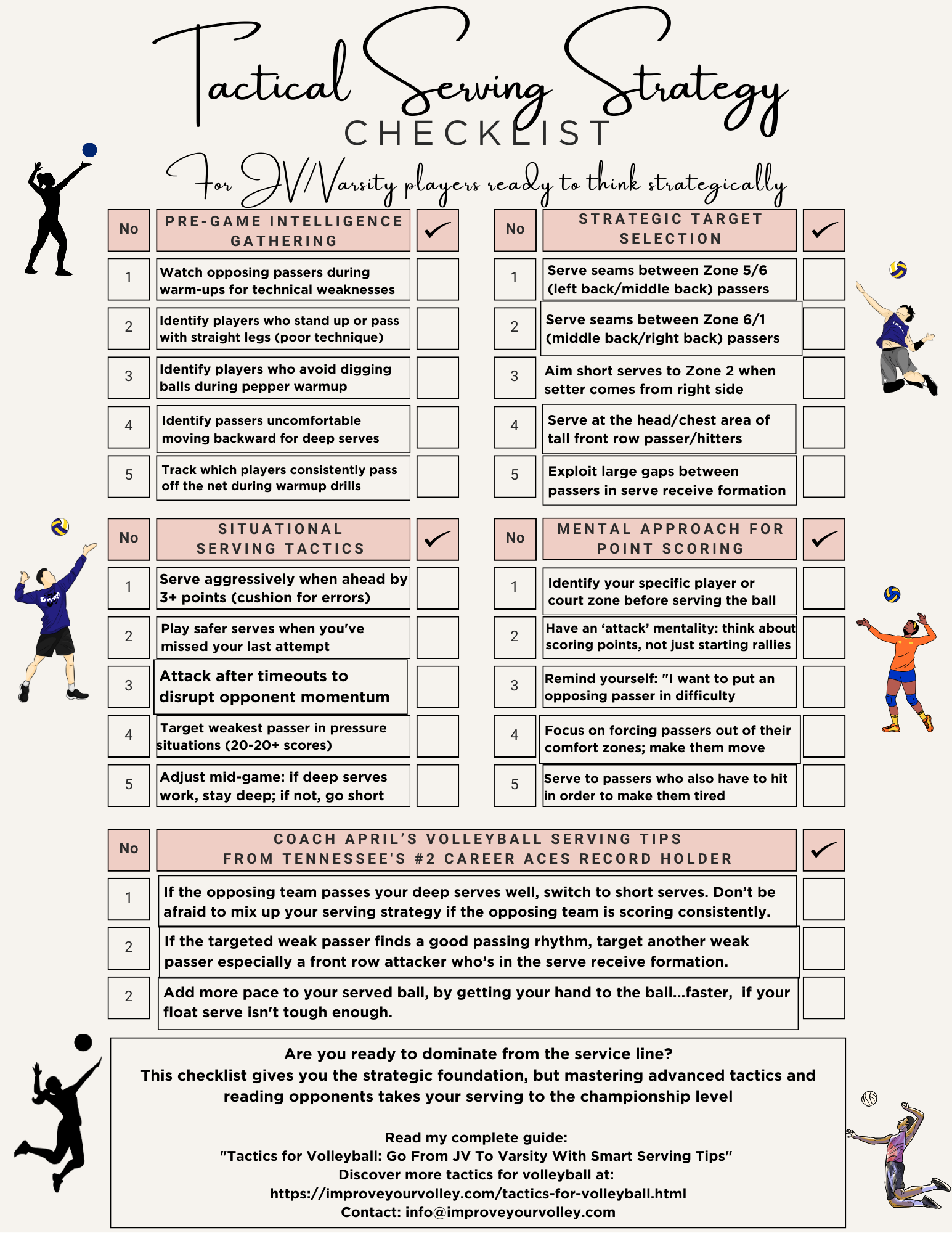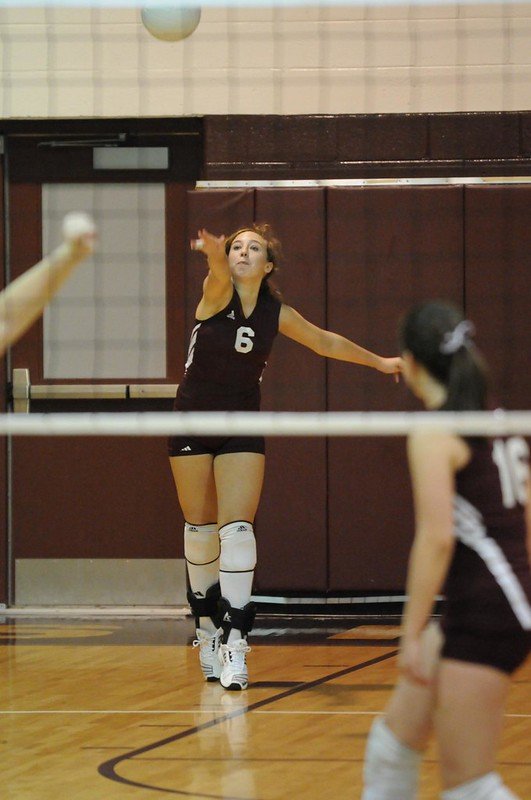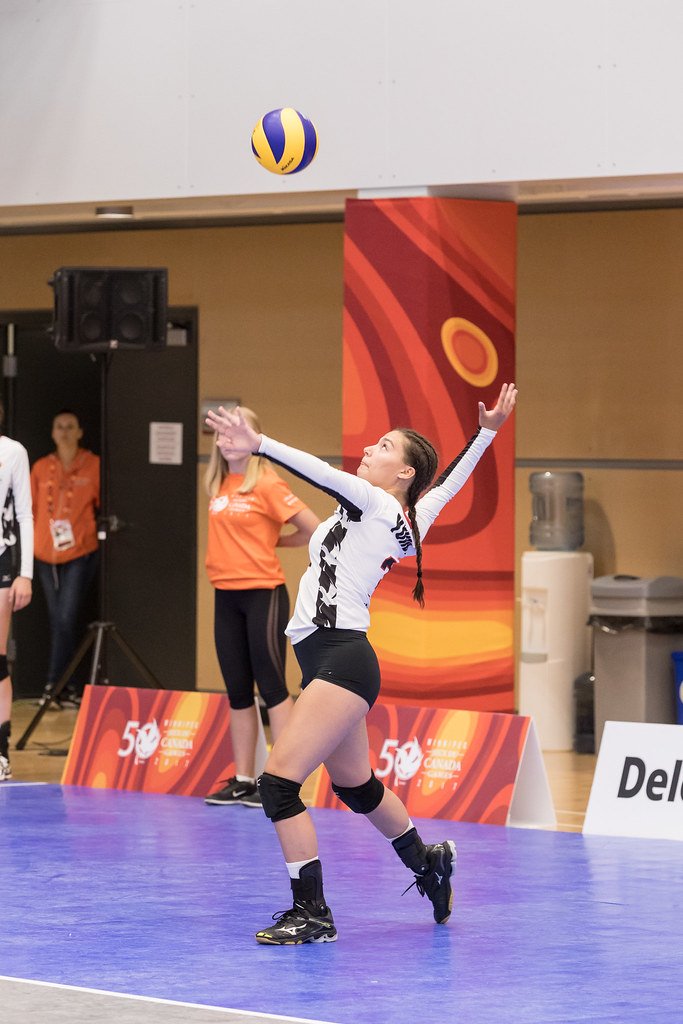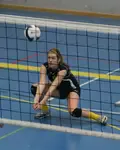- Improve Your Volleyball with Coach April
- Learn How To Coach Girls Volleyball
- Master The Float Serve in Volleyball
Master The Float Serve in Volleyball: A Guide for High School Coaches
Master the float serve in volleyball with my step-by-step guide tailored for freshman, JV, and varsity coaches. Elevate your coaching game for the preseason!
The float serve in volleyball is a powerful strategic weapon that every coach should know how to teach effectively.
The jump float serve in volleyball played an important role in the USA women's and men's Olympic teams' success which helped propel them into the medal matches to win silver and bronze medals in the Paris 2024 Olympics which just ended on August 11.
I often tell high school volleyball coaches that focusing on teaching the float volleyball serve skill should be a a priority since it offers players the first opportunity to score a point by themselves without the help of a teammate but completely and independently on their own.
I often tell coaches that I mentor, that its important to prioritize improving the standing float serve skills during high school volleyball practices.
The first chance that a player has to touch the ball at the beginning of each rally needs to turn into an opportunity to score a point or to put the opposing team in such difficulty that it isn't easy for them to get the ball back over the net.
In this article, I want to address the unique challenges and while proposing game plans for three types of high school volleyball coaches:
- Freshman or B team coaches
- Junior Varsity (JV) coaches
- Varsity coaches
What is the Float Serve in Volleyball?
Ariella and I spend a lot of time developing a tough jump float serve to anywhere I tell her on the court.
The floater serve in volleyball, also known as the float serve, is a serving technique where the ball does not spin, causing it to move and float all over the place in the air.
This unpredictability makes it difficult for the receiving team to read the ball’s flight path, which increases the chances of a passer to shank the ball giving their setter a poor pass.
Float Serving A Step-by-Step Breakdown
1. The Toss
- Tossing Accuracy is Super Important:
Many serve errors come from players who have poor tosses.
Another tip I like to talk about when discussing how to be consistent with your toss is that your tossing arm should start ..straight out in front of your body at a 90 degree angle with your palm facing up to the ceiling with the ball cradled in the palm.
For many players who have inconsistent serves they start with their tossing arm well below their waist level and the longer it takes for a younger player to swing their arm up to toss the more chances they create for themselves to
- deliver a low toss
- a toss that's too high
- a toss that's too far forward in front of you
- a toss that's too far right of your body so now you have to go from a balanced starting serve position to an unbalanced position which naturally lowers your elbow when you try and turn to your right to correct the miss-tossed ball. Now that you've lowered your elbow you've also increased your chances of serving the ball in the middle of the net.
2. Standing Float Serve Body Positioning
Addi works on her jump float serve toss consistency while aiming for a deep line serve to Zone 5.
- Serving Arm Position
Your serving arm should be fully extended above your head at a 90-degree angle.
Keep your elbow high, because keeping this position is critical to executing an effective serve.
3. Weight Transfer and Footwork
- Shifting Weight From Back Foot To Front
After the toss, shift your weight from your back foot to your front foot.
Step forward onto your opposite foot (left foot for right-handed servers) as you rotate your hips to face the net. This transition should be smooth and fluid.
4. Contacting the Ball
- High-Five The Ball
As you swing your arm forward, keep your elbow high. This minimizes the risk of shoulder irritation or injury and improves your accuracy. I tell my clients to keep their elbow slightly bent but high enough so its above the level of their ear.
- Watch The Hand To Ball Contact
Focus on watching your hand contact the ball in its center panels.
I tell clients and coaches "the middle of your hand needs to contact the middle of the ball" which is what keeps the spin off the ball when when you keep your wrist flat while contacting the ball which results in a float effect that makes the ball’s trajectory unpredictable.
Mastering this technique requires time and practice, but the outcome is worth it.
Now I want to talk about the specific strategies and challenges that I've tailored to three types of high school volleyball coaches–
- Freshman coaches
- Junior Varsity (JV) coaches
- Varsity coaches.
Click to Download Your Jump Float Volleyball Serve Mastery Checklist pdf:
🎯Jump Float Volleyball Serve Mastery Guide - $7
Are you attempting jump float serves but lacking the technical precision that creates consistent power and accuracy? Why Struggle with Jump Float Serves When You Could Master Them Systematically?
You'll Get:
Approach and Setup Methods --Master 3-step and 4-step approaches with optimal spacing and ball positioning
Jump and Timing Techniques -Perfect the slow-to-fast acceleration that creates maximum vertical lift and power
Ball Contact Fundamentals Learn the "high five" contact method for consistent float effect and accuracy
Landing and Follow-through Execute safe two-foot landings with proper hip rotation and shock absorption
Click to Download Your Tactical Serving Strategy Checklist pdf:
🎯Tactical Serving Strategy Checklist Guide - $7
Are you serving without strategic purpose while opponents easily run their offense? Why React to Opponents When You Could Be Controlling Them?
You'll Get:
Pre-game intelligence methods --Identify technical weaknesses and poor passing habits during opponent warm-ups
Strategic target selections Master seam serving and zone targeting that creates immediate passing problems
Situational serving tactics Know when to serve aggressively vs. safely based on score and game situation
Mental approach strategies Develop point-scoring mentality and force passers out of comfort zones
Coach April's tactical tips Adjust serving strategy mid-game and target front-row hitters effectively
1-page PDF checklist Convenient format you can print or keep on your device for strategic reference
Click to Download Your Consistent Toss Mastery Checklist pdf:
🎯Consistent Toss Mastery Guide - $7
Are inconsistent tosses sabotaging your serves and forcing you to chase the ball? Why fight your toss when you could master the foundation of every great serve?
Freshman Coaches: How to Float Serve for Rookies
Challenges
As a freshman coach with 2-3 years of club experience, you must develop practice plans and drills that cater to beginner volleyball athletes with one year or less of volleyball playing and training experience.
These young athletes need to establish a solid foundation and confidence through repetitive skills practice.
Game Plan:
1. Basic Standing Float Serve:
Emphasize consistency and accuracy. Have players practice tossing the ball to the same spot, and to the same height, every time.
- Body Positioning:
Teach players to hold their serving arm fully extended above their head at a 90-degree angle.
- Weight Transfer:
Guide them to shift their weight smoothly from the back foot to the front foot for better control.
2. Volleyball Serving Drills for Freshmen:
- Wall Serves:
Players practice serving against a wall to focus on hand contact and the toss.
- Target Practice:
Set targets in different zones of the court, encouraging players to improve their accuracy.
- Partner Work:
That's five different areas the server can practice aiming for.
After sets of 20 the players rotate so that left back passer moves to middle back passer and middle back passer becomes the next server to serve 20 balls.
Junior Varsity Coaches:
Perfecting Your Floater in Volleyball
Challenges:
As a JV coach with 3-5 years of experience, your focus should transition from teaching the beginner skills to fine tuning intermediate skills so players create consistent movements before during after contacting the ball and introducing more advanced techniques players will use more often at "the next level" like the jump float serve.
Game Plan:
1. Transition to Jump Float Serve:
- Footwork:
Teach proper footwork, focusing on consistent serve approach steps and how to execute an explosive jump for each serve attempt.
- Hand Contact:
Emphasize contacting the ball in the center with the flat upper palm of the hand for a minimal spin.
2. Advanced Drills:
- Jump Float Serve Progressions:
Break down the serve -
- the approach
- the jump
- the arm swing
- the landing
- the body positioning in each of these phases from lower body to upper body positioning – practicing each part separately before combining them.
- Pressure Drills:
Simulate game-like pressure situations where players score points based on their serve’s accuracy and difficulty.
No points are awarded if one person missed their serve. The goal is for the team to get 50% or more serves in the first round, 65% the second round and 75% IN the third round.
No pressure!
They also have to stay in rhythm with very little pre-serve prep while still focusing on what each body part needs to to do when contacting the ball before during after their jump.
- Role Reversal:
** Allow players to switch roles between serving and passing to understand both perspectives.
Varsity Coaches: Mastering the Overhand Float Serve in Volleyball
Challenges:
As an experienced varsity coach with over six years of coaching, your goal is perfecting the technical and strategic aspects of the float serve, ensuring players perform under competitive pressure.
During my Breakfast Club for College Players summer training for college players in Vegas home for the summer we work on partner jump float serving technique where two servers at a time in two different lines serve behind Zone 1 and Zone 5 to a designated spot on the opposing court.
Pairs work together to get the ball "in" and if one player in the serving pair misses their serve neither of the two score a point for their team.
So no point for the two people serving and no point for the team they represent so the pressure feels like its double the weight.
The more we do this drill the more the server feels the weight of making their serve in.
Game Plan:
1. Perfecting Technique:
- Regularly review the mechanics of the float serve and jump float serve, ensuring players maintain their form under different conditions.
- Use video analysis to identify areas for improvement.
2. Strategic Drills:
- Game-Like Situations:
Design drills where successful serves score points, mimicking match pressure.
- Zone Serving:
Teach players to aim for specific zones on the opponent’s court, exploiting weaknesses.
- Team Challenges:
Set up competitions where players must serve a certain number of successful float serves, fostering team spirit and accountability.
My College Breakfast Club training group working on jump float serve skills specifically hand to ball and toss consistency.
Do You Follow Me on Pinterest?
Follow me on Pinterest Volleybragswag to improve your game even faster!
I share alot of individual, partner and easy-to-do volleyball serving drills we do in class with my followers.
Many of these volleyball practice drills you can do at home by yourself or try at your next practice with your teammates.
If you're a B team or JV player trying to make varsity next year...your goal should be to complete 1000 reps a day of at least three of the basic skills on your own...volleyball passing, serving and setting should be at the top of the list.
Meet Tatoo the Tiger, Serving Specialist on VolleyBragSwag's All Beast Team
Serve A Volleyball Overhand For Points Consistently Score More Aces
Where Do You Go From Here?
Where do you need to go now? Here are three options:
- Learn more about How To Play Volleyball.
- Follow the suggested reading on our Sitemap page Learning How To Play (Sitemap)
- Or visit the pages to learn more about the volleyball serve in the Related Links below
If your athlete struggles with consistent serve receive, gets subbed out, or is overlooked for playing time—this is the fix you’ve been looking for.

Struggling with passing consistency?
I help talented passers tired of getting pulled from games because of inconsistent serve receive skills BUILD passing confidence without expensive private lessons using the same 3-step system that's helped dozens of my athletes get recruited.
Download my eBook for $17.99 and start building the passing confidence that keeps you on the court—and gets you seen by college coaches.
From Lady Vol to Legend: Coach April Produces Powerful Passionate Players...is that you?
What Are You Looking For?
Click to Download Your Pre Serving Ritual Mastery Checklist pdf:
🎯Volleyball Pre Serving Ritual Guide -
Players! Learn How To Transform Your Serve from Weak to Weapon
Click to Download Your Parent's Volleyball Serving Checklist pdf
🎯Parent's Volleyball Serving Checklist Guide
Parents! Help Your Player Develop Championship Serves (Even If You've Never Played)

Hi there!
Thanks for stopping by. Hope you learned something today that will help you reach your volleyball goals.
Be sure to subscribe to my email newsletter so you can learn more each week!
Stay strong! Stay motivated!
-Coach April

SUSCRIBE to my email newsletter below!
 Click to learn more about the weekly volleyball classes and clinics or email info@imrpoveyourvolley.com for information
Click to learn more about the weekly volleyball classes and clinics or email info@imrpoveyourvolley.com for informationCongratulations to my seven Boys-18s Vegas Volley club players who played in two state championship finals yesterday, the 3A and 5A State champinship finals at Sunrise Mountain High School.
TOURNAMENT CHAMPIONS!
A-1 Vegas Volley VBC
In It To Win It Tournament
May 2 - 4, 2025 Tournament
Gold Medalists
18s Premier Division
Vegas Volleyball's Unsung Heroes: Celebrating Moms with Peace Love Volleyball Shirts
Ready to energize your volleyball mom journey?
Subscribe to my 'Producing Powerful Passionate Peaceful Players' email list above on ImproveYourVolley.com.
You'll receive energy-boosting tips, exclusive insights from me, Coach April Chapple on maintaining momentum in volleyball.
Let's power up the Vegas volleyball scene together!
Recent Articles
-
3 Exercises To Improve Spike Skills By Hitting With A Faster Armswing
Jan 06, 26 01:13 AM
These 3 volleyball exercises to improve spike skills by hitting more balls in the court with a quick armswing and aggressive spike approach to beat blockers. -
Your Serve in Volleyball: 10 Tips To Get You From Bench to Starter
Jan 02, 26 03:41 PM
I hold Tennessee's #2 career aces record (244 aces). Last month I coached 7 players to state finals. These 10 serving tips separate legends from bench players. -
Overhand Jump Serve Volleyball Tips To Score Many More Points and Aces
Jan 02, 26 03:14 PM
My "Coach April Overhand Jump Serve Volleyball Tips" designed to help you increase your serving accuracy, power and the ability to serve more aces in volleyball.





